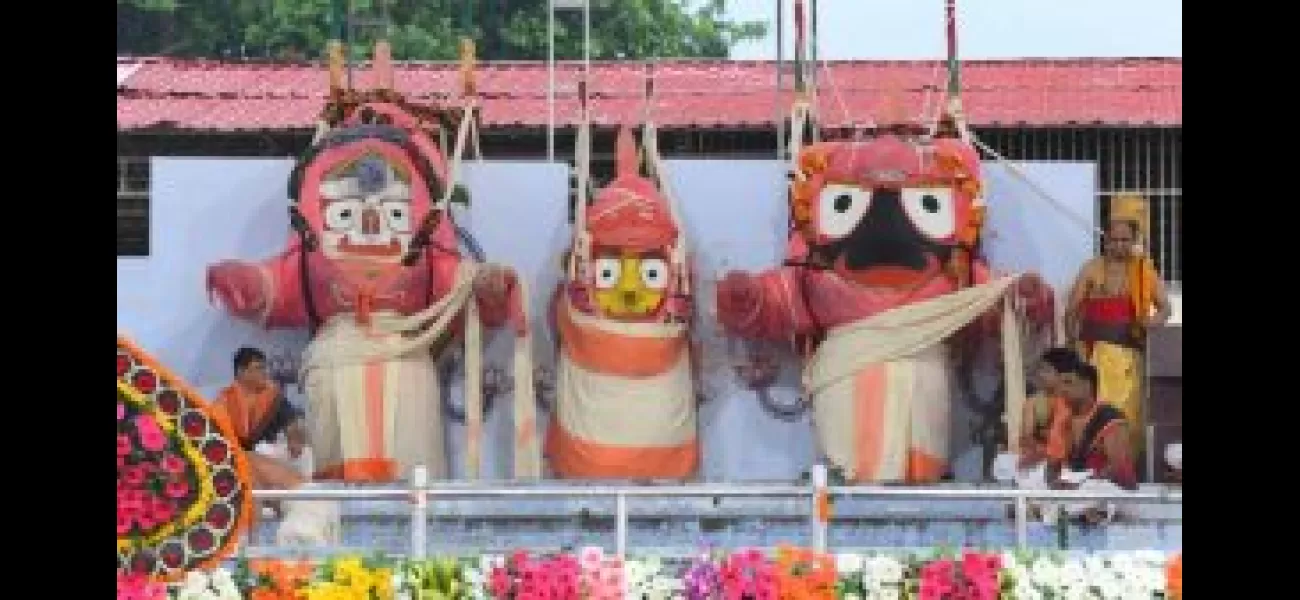The Debasnana Purnima festival involves taking a holy bath and dressing up elephants for a divine experience.
One of the biggest festivals in Odisha and other parts of India is the Rath Yatra, with the highlight being the Debasnana Purnima or Snana Purnima, where the deities are bathed and adorned in Hati Besha or Gajanana Besha.
June 22nd 2024.

The Rath Yatra is a world-renowned festival that is celebrated with great fervor not only in Odisha but also in various parts of the country. However, at the heart of this grand event lies the Debasnana Purnima, also known as Snana Purnima, where the deities are given a sacred bath followed by the magnificent Hati Besha. This tradition involves adorning the deities, Lord Jagannath, Lord Balabhadra, and Goddess Subhadra, in elephant attire, signifying their majestic appearance as elephants.
But have you ever wondered about the origin of this sacred tradition? As the holy day of Snana Purnima approaches, Sunday POST takes a closer look at the rituals and the legend behind this grand event.
The ritual of Hati Besha takes place on the full moon day in the month of Jyestha, also known as Snana Purnima. On this auspicious day, the deities are ceremoniously brought in a procession to the Snana Bedi, a bathing platform located in Ananda Bazar. The bathing ritual involves the use of scented water, which is prepared with great devotion by the servitors since the previous night. After the deities receive their ceremonial bath, the servitors proceed to the mutts to procure materials for the adornment of the idols. These materials, essential for the besha, are acquired from Gopal Tirtha Mutt and Raghab Das Mutt. Once the besha is completed, offerings are made to the deities, giving devotees the opportunity to witness their divine presence and seek their blessings.
The legend of Hati Besha dates back to the story of Lord Jagannath and Ganapati Bhatta. Ganapati Bhatta, a devout seeker from Karnataka, was a follower of the Ganapatya sampradaya, which worships Lord Ganesha as the supreme deity. Upon hearing about Lord Jagannath from the Brahma Purana, he embarked on a pilgrimage to Shrikshetra Puri in the hopes of experiencing the divine grace of Jagannath. However, upon catching a glimpse of the deity, his heart sank as Lord Jagannath did not have the elephant head that he associated with his beloved Ganesha. Disheartened, he left the premises, as his devotion was solely reserved for Lord Ganesha.
Realizing the dissatisfaction of his devotee, Lord Jagannath devised a plan to address Bhatta's devotion and provide him with solace. In the guise of a learned Brahmin, Lord Jagannath met Bhatta, who was about to leave Puri. The Brahmin assured him that he did not have to leave Shrikshetra disheartened and encouraged him to visit the temple once again in the evening. Little did Bhatta know that a wondrous surprise was waiting for him at the temple.
Filled with anticipation, Bhatta returned to the temple in the evening, guided by the promise bestowed upon him by the enigmatic Brahmin. To his delight, he witnessed Lord Jagannath adorned in Hati Besha, resembling his beloved Lord Ganesha. Overwhelmed with joy and gratitude, Bhatta repeatedly bowed to the deity, realizing that Lord Jagannath was the Supreme Lord himself. He understood that everything in the world comes from this holy source and that all beings are related to each other and to the Supreme Lord.
Following the holy bath on Jyestha Purnima, the deities take up Gajanana Besha annually. However, after the bath, they suffer from fever and are taken to the anabasar house for treatment. During this period of rest, only designated servitors are allowed to attend to the deities, administering medicines and aiding in their recovery. Devotees are prohibited from having darshan of the deities during this fortnight. Once they are fully recovered, the deities embark on their annual journey, the Ratha Jatra, in a grand procession from the Shreemandira to their birthplace, the Shree Gundicha Temple. This grand festival is a celebration of the divine bond between the deities and their devotees, and the story of Hati Besha is a reminder of the limitless love and compassion of the Supreme Lord.
But have you ever wondered about the origin of this sacred tradition? As the holy day of Snana Purnima approaches, Sunday POST takes a closer look at the rituals and the legend behind this grand event.
The ritual of Hati Besha takes place on the full moon day in the month of Jyestha, also known as Snana Purnima. On this auspicious day, the deities are ceremoniously brought in a procession to the Snana Bedi, a bathing platform located in Ananda Bazar. The bathing ritual involves the use of scented water, which is prepared with great devotion by the servitors since the previous night. After the deities receive their ceremonial bath, the servitors proceed to the mutts to procure materials for the adornment of the idols. These materials, essential for the besha, are acquired from Gopal Tirtha Mutt and Raghab Das Mutt. Once the besha is completed, offerings are made to the deities, giving devotees the opportunity to witness their divine presence and seek their blessings.
The legend of Hati Besha dates back to the story of Lord Jagannath and Ganapati Bhatta. Ganapati Bhatta, a devout seeker from Karnataka, was a follower of the Ganapatya sampradaya, which worships Lord Ganesha as the supreme deity. Upon hearing about Lord Jagannath from the Brahma Purana, he embarked on a pilgrimage to Shrikshetra Puri in the hopes of experiencing the divine grace of Jagannath. However, upon catching a glimpse of the deity, his heart sank as Lord Jagannath did not have the elephant head that he associated with his beloved Ganesha. Disheartened, he left the premises, as his devotion was solely reserved for Lord Ganesha.
Realizing the dissatisfaction of his devotee, Lord Jagannath devised a plan to address Bhatta's devotion and provide him with solace. In the guise of a learned Brahmin, Lord Jagannath met Bhatta, who was about to leave Puri. The Brahmin assured him that he did not have to leave Shrikshetra disheartened and encouraged him to visit the temple once again in the evening. Little did Bhatta know that a wondrous surprise was waiting for him at the temple.
Filled with anticipation, Bhatta returned to the temple in the evening, guided by the promise bestowed upon him by the enigmatic Brahmin. To his delight, he witnessed Lord Jagannath adorned in Hati Besha, resembling his beloved Lord Ganesha. Overwhelmed with joy and gratitude, Bhatta repeatedly bowed to the deity, realizing that Lord Jagannath was the Supreme Lord himself. He understood that everything in the world comes from this holy source and that all beings are related to each other and to the Supreme Lord.
Following the holy bath on Jyestha Purnima, the deities take up Gajanana Besha annually. However, after the bath, they suffer from fever and are taken to the anabasar house for treatment. During this period of rest, only designated servitors are allowed to attend to the deities, administering medicines and aiding in their recovery. Devotees are prohibited from having darshan of the deities during this fortnight. Once they are fully recovered, the deities embark on their annual journey, the Ratha Jatra, in a grand procession from the Shreemandira to their birthplace, the Shree Gundicha Temple. This grand festival is a celebration of the divine bond between the deities and their devotees, and the story of Hati Besha is a reminder of the limitless love and compassion of the Supreme Lord.
[This article has been trending online recently and has been generated with AI. Your feed is customized.]
[Generative AI is experimental.]
0
0
Submit Comment





